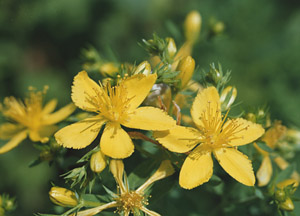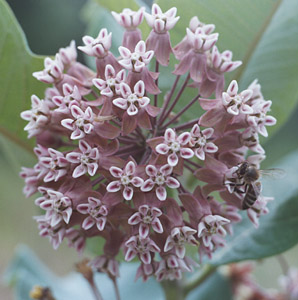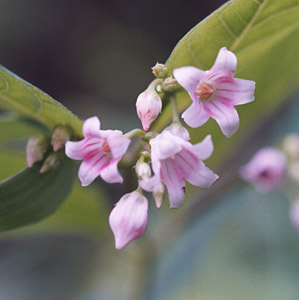
Common St. Johnswort, St. Johnswort family (Guttiferae), Alien
 |

Out west, the plant is known as Klamath weed. It spreads aggressively in some areas, and in places a
moth has been introduced as a biological control to keep it in check.
Common Milkweed, Milkweed family (Asclepiadaceae), Native

Found in open fields at the Reservoir, common milkweed (Asclepias syriaca) produces droopy
clusters of small, unique-looking pinkish flowers. It blooms in the summer, often starting in June.
In the fall, typically in late September or early October, its large, pointed seedpods burst open,
releasing seeds borne on silky, fluffy strands that float on the breezes.
Milkweed is named for its thick white sap. The sticky juice often traps ants and other small crawling insects that climb the stout stems in search of nectar. The sap also contains chemicals known as cardiac glycosides, which make it acrid and unpalatable to grazing animals. The cardiac glycosides can affect animal heart muscle.
 |
 |
 |
 |
Milkweed plants typically harbor a diversity of insects. The flowers have a sweet scent, especially at night, and abundant nectar. They attract pollinators such as bumblebees, honey bees, wasps, and butterflies during the day, and moths come at night. Other insects, such as yellow jackets and pale, camouflaged crab spiders, prey upon the pollinators.
At least three insects feed only on milkweed and get a special benefit from doing so. The caterpillar of the monarch butterfly (Danaus plexippus), which is known as a "milkweed butterfly", eats the leaves. The milkweed beetle (Tetraopes tetraophthalmus) feeds on the stems and roots, and the small milkweed bug (Lygaeus kalmii) consumes the seeds. These insects have evolved a tolerance for the milkweed's cardiac glycosides, which in turn make the insects noxious to predators, who quickly learn to avoid toxic meals.
Even after metamorphosis from caterpillar to butterfly, monarchs retain the milkweed's cardiac glycosides in their bodies. They take nectar from other flowers besides milkweed but remain poisonous to birds that would feed upon them. Birds have actually been photographed as they vomit after eating a monarch butterfly.
Milkweed plants typically establish themselves quickly, sinking roots so deeply into the ground that farmers find them hard to get rid of. The original plant spreads slowly by underground runners, forming clumps of plants that are genetically identical. For cross-pollination, milkweed depends on sturdy long-distance travelers, such as bumblebees and butterflies, that can easily fly from one clump to another.
North America has approximately 75 species of milkweed, but most of the 2,000 plants in the milkweed
family are tropical plants.

Spreading Dogbane, Dogbane Family (Apocynaceae), Native


|

In spite of its beauty, the plant is considered poisonous to mammals, including dogs, cows, and humans. Native Americans, however, had numerous medicinal uses for the root. Chemicals that affect the heart have also been extracted from spreading dogbane.
The plant can also be deadly to flies, moths, and other small insects that come for its nectar but are not the right size to pollinate the flowers. These insects can get trapped by their tongues in the flowers and left dangling there.
Spreading dogbane is related to the milkweeds. Like them, it has milky sap and seed pods containing fluffy
fibers with seeds attached. The seed pods form in pairs and open in the fall.
| show TOC frame | Table of Contents | 
|
| Home / Contact | ||
Copyright © Anne A. Reid, 1999-2002. Photographs copyright © Garry K. Kessler, 1999-2002. | ||